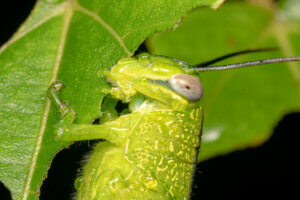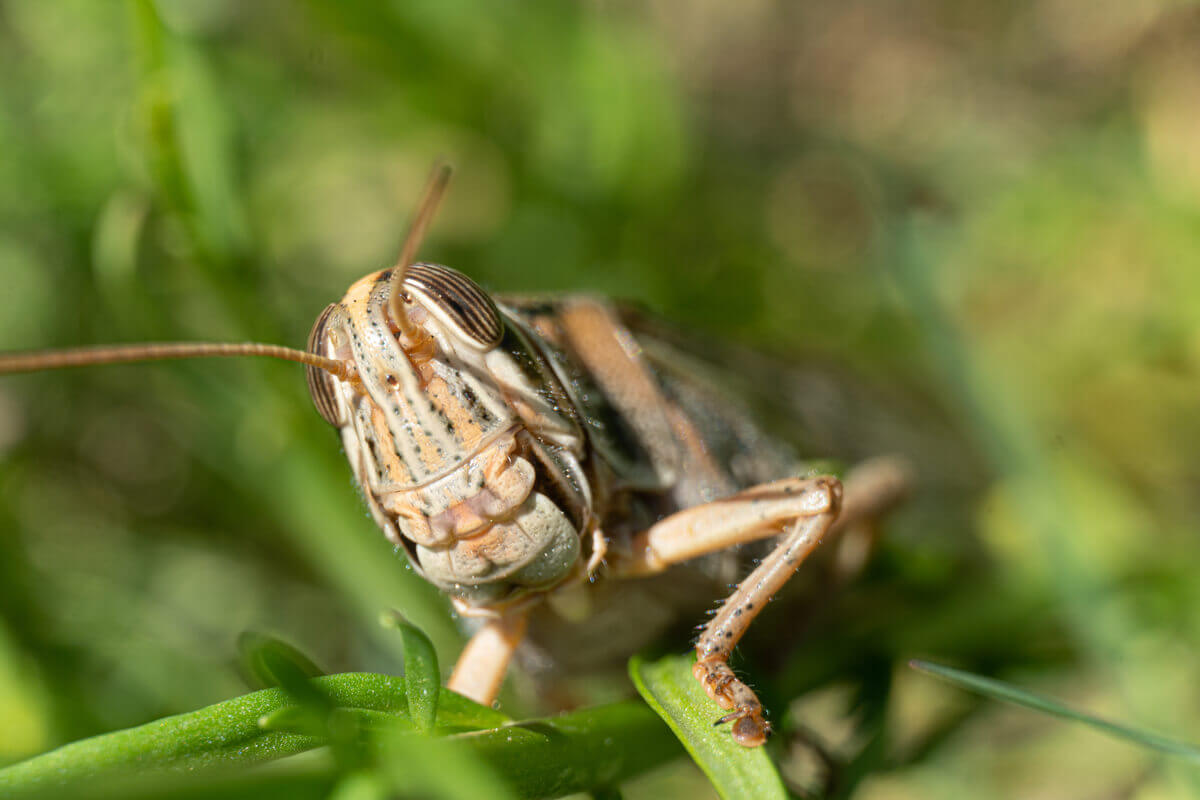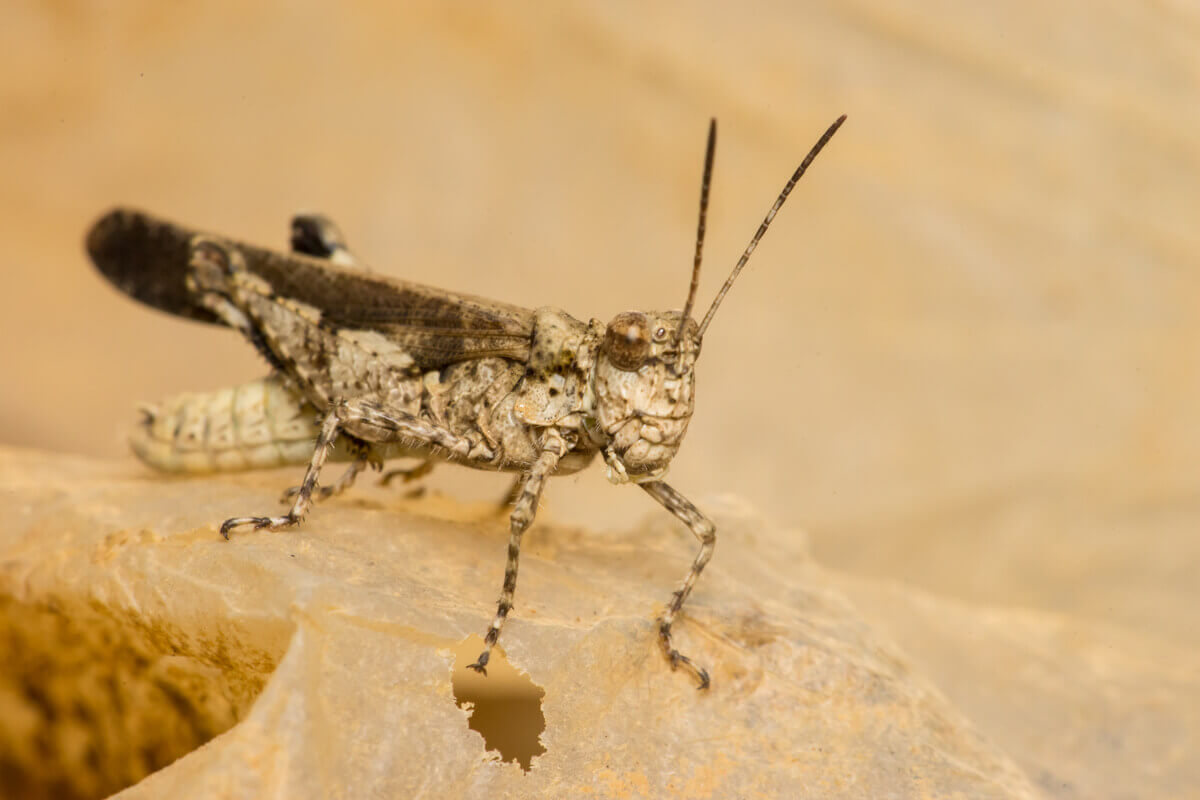What Do Grasshoppers Eat?

Grasshoppers are a group of insects that have a wide distribution throughout the world. These animals belong to the suborder Caelifera, which consists of about 7000 species. Their most representative features are their long, strong legs, which allow them to jump. Although we’ve all seen these small invertebrates jump and fly around our gardens, they have many characteristics that most of us are unaware of. For example, do you know what grasshoppers eat?
These insects are primarily herbivores, which is why we know them as crop pests. But, there are many other non-harmful species that are endangered, according to the International Union for Conservation of Nature (IUCN).
A chewing mouthpiece
Within this class of insects, we can find a great diversity of specialized oral structures. At the same time, we can observe atypical morphologies in other segments: wings, extremities, or antennas. The different groups of insects are classified according to the shape of these structures.
If we look at the insects’ oral apparatus, we can deduce what type of food makes up their diet. In that sense, there are chewing devices, perforators or suckers, siphoners and lickers. Grasshoppers have specialized maxillary and mandibular structures for chewing, as do dragonflies, and beetles.
This type of apparatus is also present in the larval stage of many insects that, in their adult phase, have other types of mouth apparatus. An example here are caterpillars, since the adults suck nectar from the flowers through their trunks.
A chewing mouthpiece consists of four different parts:
- A pair of jaws: Grasshoppers have a pair of jaws, located behind the labrum (lip) and in front of the maxilla. In chewing insects, these are the largest and strongest structures, with which they can cut and crush food. In addition to serving for food, the jaws also play a role in defense.
- A pair of maxilla: These are segmented and located behind the jaws. With them, the grasshopper manipulates food.
- Lip or labrum: This also helps in the manipulation of food. It has a square appearance in chewing insects, but can be specialized in other different structures.
- Hypopharynx: Finally, this is a small element, located between the maxillae and behind the jaws. It intervenes in the digestion of the food, since it acts as a kind of tongue that helps to mix food with saliva.

Grasshopper diet
They’re phytophagous animals, meaning that grasshoppers eat plants. Pieces missing from the leaves, tunnels, and holes or the destruction of plant tissue are evidence of the presence of a chewing insect like a grasshopper.
What type of plants does the grasshopper eat?
As a group, grasshoppers vary from monophagous eaters – having a super-specialized diet – to polyphagous – eating different types of food. However, most species are in the oligophagous group. This means that they have a preference for a few plant species.
In some species, feeding trends are more defined; some grasshoppers prefer to feed in pasture areas and others on perennial grasses. But, in general, the feeding patterns of herbivorous insects are influenced by physical, chemical, and climatic factors.
The choice of what grasshoppers eat in their diet isn’t just random, as it can affect their survival and reproduction rates. For example, grasshoppers raised exclusively on alfalfa have very low fecundity and survival rates compared to those fed a varied diet in a laboratory setting.
Grasshoppers choose their diet
The choice of plants by grasshoppers is highly influenced by many different factors. Sometimes it’s difficult to identify which one is at stake in each insect community and how much of an influence it has. Here are some of them:
- Availability of nutrients
- Nutritional properties of food plants
- Sensory capabilities of insects
- Skills of grasshoppers to detoxify different plants with defensive substances
- Competitors present in the environment
- Mobility and dispersion capacity of the grasshopper species
- Phylogenetic limitations
Omnivorous feeding and grasshoppers
Like we said before, most grasshoppers are herbivores. However, other species also feed on other small insects or animal feces and tissue.
For example, the species Melanoplus sanguinipes and Ageneotettix deorum are capable of feeding on the feces of other grasshoppers. At the same time, the grasshopper subfamily Listroscelidinae includes predators such as the green grasshopper (Tettigonia viridissima), which can feed on small insects or larvae.

Grasshoppers are a group of insects that have a wide distribution throughout the world. These animals belong to the suborder Caelifera, which consists of about 7000 species. Their most representative features are their long, strong legs, which allow them to jump. Although we’ve all seen these small invertebrates jump and fly around our gardens, they have many characteristics that most of us are unaware of. For example, do you know what grasshoppers eat?
These insects are primarily herbivores, which is why we know them as crop pests. But, there are many other non-harmful species that are endangered, according to the International Union for Conservation of Nature (IUCN).
A chewing mouthpiece
Within this class of insects, we can find a great diversity of specialized oral structures. At the same time, we can observe atypical morphologies in other segments: wings, extremities, or antennas. The different groups of insects are classified according to the shape of these structures.
If we look at the insects’ oral apparatus, we can deduce what type of food makes up their diet. In that sense, there are chewing devices, perforators or suckers, siphoners and lickers. Grasshoppers have specialized maxillary and mandibular structures for chewing, as do dragonflies, and beetles.
This type of apparatus is also present in the larval stage of many insects that, in their adult phase, have other types of mouth apparatus. An example here are caterpillars, since the adults suck nectar from the flowers through their trunks.
A chewing mouthpiece consists of four different parts:
- A pair of jaws: Grasshoppers have a pair of jaws, located behind the labrum (lip) and in front of the maxilla. In chewing insects, these are the largest and strongest structures, with which they can cut and crush food. In addition to serving for food, the jaws also play a role in defense.
- A pair of maxilla: These are segmented and located behind the jaws. With them, the grasshopper manipulates food.
- Lip or labrum: This also helps in the manipulation of food. It has a square appearance in chewing insects, but can be specialized in other different structures.
- Hypopharynx: Finally, this is a small element, located between the maxillae and behind the jaws. It intervenes in the digestion of the food, since it acts as a kind of tongue that helps to mix food with saliva.

Grasshopper diet
They’re phytophagous animals, meaning that grasshoppers eat plants. Pieces missing from the leaves, tunnels, and holes or the destruction of plant tissue are evidence of the presence of a chewing insect like a grasshopper.
What type of plants does the grasshopper eat?
As a group, grasshoppers vary from monophagous eaters – having a super-specialized diet – to polyphagous – eating different types of food. However, most species are in the oligophagous group. This means that they have a preference for a few plant species.
In some species, feeding trends are more defined; some grasshoppers prefer to feed in pasture areas and others on perennial grasses. But, in general, the feeding patterns of herbivorous insects are influenced by physical, chemical, and climatic factors.
The choice of what grasshoppers eat in their diet isn’t just random, as it can affect their survival and reproduction rates. For example, grasshoppers raised exclusively on alfalfa have very low fecundity and survival rates compared to those fed a varied diet in a laboratory setting.
Grasshoppers choose their diet
The choice of plants by grasshoppers is highly influenced by many different factors. Sometimes it’s difficult to identify which one is at stake in each insect community and how much of an influence it has. Here are some of them:
- Availability of nutrients
- Nutritional properties of food plants
- Sensory capabilities of insects
- Skills of grasshoppers to detoxify different plants with defensive substances
- Competitors present in the environment
- Mobility and dispersion capacity of the grasshopper species
- Phylogenetic limitations
Omnivorous feeding and grasshoppers
Like we said before, most grasshoppers are herbivores. However, other species also feed on other small insects or animal feces and tissue.
For example, the species Melanoplus sanguinipes and Ageneotettix deorum are capable of feeding on the feces of other grasshoppers. At the same time, the grasshopper subfamily Listroscelidinae includes predators such as the green grasshopper (Tettigonia viridissima), which can feed on small insects or larvae.

All cited sources were thoroughly reviewed by our team to ensure their quality, reliability, currency, and validity. The bibliography of this article was considered reliable and of academic or scientific accuracy.
- Eric E. Porter, Richard A. Redak, Diet of Migratory Grasshopper (Orthoptera: Acrididae) in a California Native Grassland and the Effect of Prescribed Spring Burning, Environmental Entomology, Volume 26, Issue 2, 1 April 1997, Pages 234–240.
- Joern, A. Feeding patterns in grasshoppers (Orthoptera: Acrididae): Factors influencing diet specialization. Oecologia 38, 325–347 (1979).
- Behmer, S. T., and A. Joern. “Diet Choice by a Grass-Feeding Grasshopper Based on the Need for a Limiting Nutrient.” Functional Ecology, vol. 7, no. 5, 1993, pp. 522–527.
- Kevin M. O’Neill, Stephen A. Woods, Douglas A. Streett, Grasshopper (Orthoptera: Acrididae) Foraging on Grasshopper Feces: Observational and Rubidium-Labeling Studies, Environmental Entomology, Volume 26, Issue 6, 1 December 1997, Pages 1224–1231.
This text is provided for informational purposes only and does not replace consultation with a professional. If in doubt, consult your specialist.








